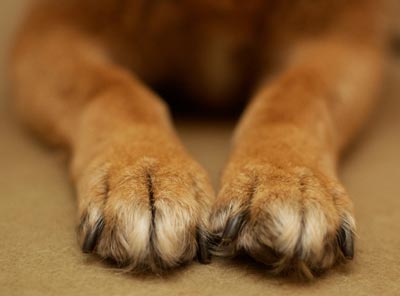Claws vs. Nails: What Do Dogs Have?

Did you know that claws and nails aren't the same thing? They're not, and dogs have claws. Here are some of the differences between the two structures and some other interesting facts about dogs' claws.
Claws Have Nerves and Blood Vessels
Claws contain nerves and blood vessels, while nails do not. That's why a dog's claw will sometimes bleed when it is cut short, and it is also sometimes why dogs cry or pull away during claw trimming.
Claws Are Attached to Bone
Humans have nails, which are dull, flat, and sit on top of the ends of our fingers and toes. Claws, in contrast, come to a point and protrude from the ends of the toes.
Nails grow from cuticles, structures in the skin that support, feed, and promote nail growth. Claws come directly out of the phalanx bones at the end of a dogs' toes.
Claws Are Meant for Use
Claws perform jobs for those that have them. In some animals, claws are meant for digging or climbing. In others, like dogs, they're meant for grabbing and holding onto prey. Our human nails can't do those things nearly as well.
The term "nails" is often used interchangeably with "claws," especially when talking about trimming. It is fine to interchange the terms as long as it is understood that a dog's claws have some different properties and need particular care.
Claws Can Have Problems
A dog's claws are a part of their body that need our attention to ensure they stay healthy. Some dogs need routine claw trims while others wear theirs down naturally. Various diseases, tumors, and injuries can affect claws, so they should be regularly examined for any changes.
You can learn how to trim your dog's claws here: "Helpful Tips for Trimming Your Dog's Nails."
The best thing you can do for your dog's claw care is get him used to having them looked at and trimmed. You can do this by gently handling his paws from a young age, giving him gentle praise when he allows it.
You May Also Like These Articles:
Helpful Tips for Trimming Your Dog's Nails
Minor Dog Injuries and Illnesses and What to Do
Play Bow: What Does This Common Dog Behavior Mean?
Tips for Feeding a Hungry, Overweight Dog
Necessary Pet Cleaning Supplies for Dogs
How to Make Canned Food into Treats for Your Dog
Disclaimer: This website is not intended to replace professional consultation, diagnosis, or treatment by a licensed veterinarian. If you require any veterinary related advice, contact your veterinarian promptly. Information at DogHealth.com is exclusively of a general reference nature. Do not disregard veterinary advice or delay treatment as a result of accessing information at this site. Just Answer is an external service not affiliated with DogHealth.com.
Notice: Ask-a-Vet is an affiliated service for those who wish to speak with a veterinary professional about their pet's specific condition. Initially, a bot will ask questions to determine the general nature of your concern. Then, you will be transferred to a human. There is a charge for the service if you choose to connect to a veterinarian. Ask-a-Vet is not manned by the staff or owners of DogHealth.com, and the advice given should not delay or replace a visit to your veterinarian.



